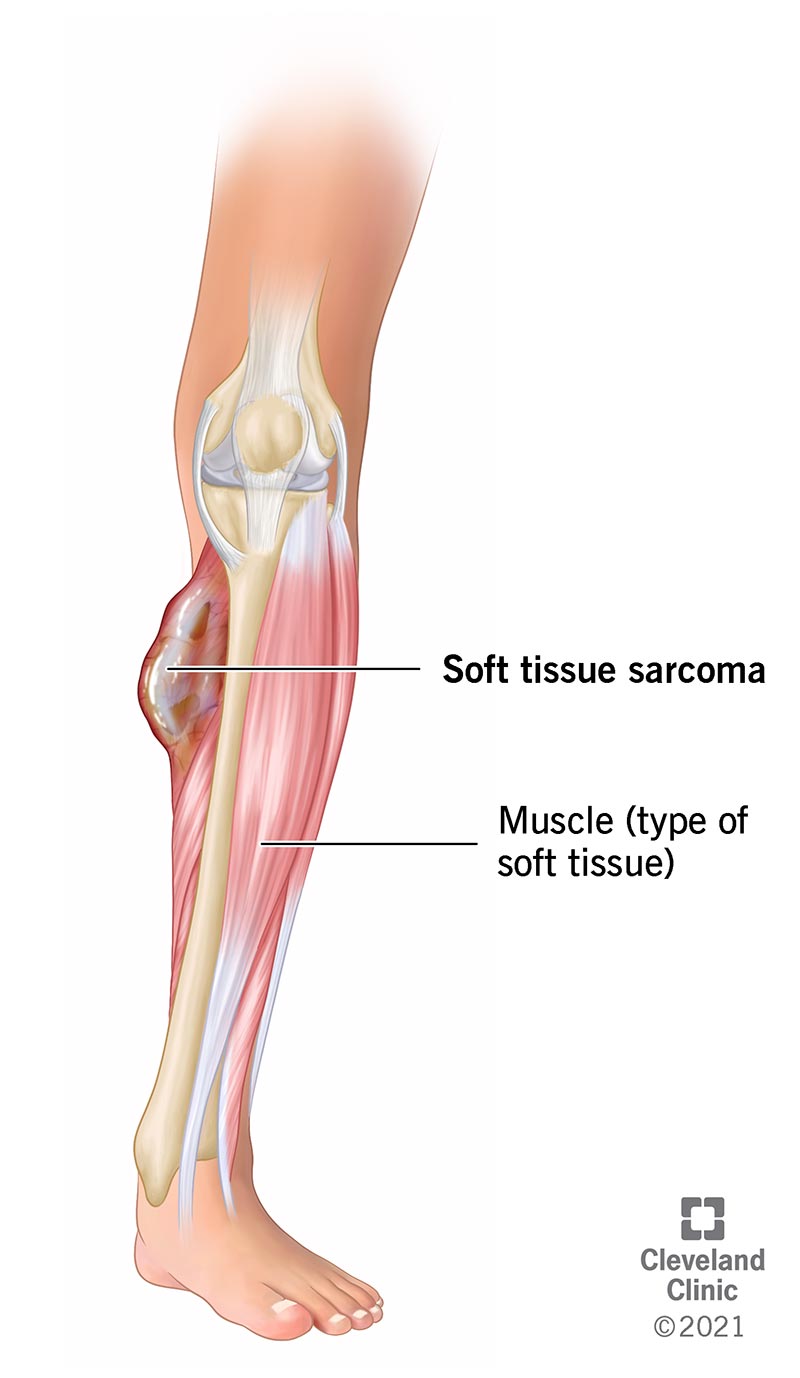Soft tissue sarcoma is a rare cancer. It causes cancerous tumors that can affect muscles, ligaments, tendons and other soft tissue in your body. There are more than 70 types of soft tissue sarcoma. You can have a soft tissue sarcoma for months or years before you have symptoms. Treatment is surgery to remove the cancerous tumor.
Advertisement
Cleveland Clinic is a non-profit academic medical center. Advertising on our site helps support our mission. We do not endorse non-Cleveland Clinic products or services. Policy

“Soft tissue sarcoma“ is an overarching term for rare, cancerous tumors in your soft tissues. You have soft tissues everywhere in your body, including your:
Advertisement
Cleveland Clinic is a non-profit academic medical center. Advertising on our site helps support our mission. We do not endorse non-Cleveland Clinic products or services. Policy
Soft tissue sarcoma typically affects your arms, legs, chest and the back of your belly (retroperitoneum). Adults are more likely than children to have a type of soft tissue sarcoma.
There are more than 70 different types of soft tissue sarcoma. Some types, like liposarcoma, have several subtypes. Types of soft tissue sarcoma are:
Advertisement
Most soft tissue sarcomas grow very slowly. You can have one for months or years before you have symptoms. You should contact a healthcare provider if you have:
Experts don’t know the exact cause. Genetic mutations cause some soft tissue sarcomas. There are also inherited disorders and activities that increase your risk of having this condition. For example, some inherited disorders can increase your risk, including:
Other risk factors include:
A healthcare provider will ask about your symptoms. They’ll examine any unusual lumps or bumps that they can see and feel. They’ll do a physical exam to look for other symptoms. They may do the following imaging tests:
Your provider may refer you to a surgical oncologist if imaging tests detect cancer. Your surgical oncologist may do a biopsy to get a small amount of tissue.
A medical pathologist will examine the tissue under a microscope. They may do several tests to identify the sarcoma type, stage and grade. Tumor grade is how pathologists find out if a tumor is likely to grow slowly, fast or spread.
Healthcare providers use cancer staging systems to develop treatment plans and prognoses (what you can expect if you have soft tissue sarcoma). They consider the following factors in staging soft tissue sarcoma:
The most common treatment is surgery to remove a cancerous tumor. Your surgical oncologist may work with a medical oncologist. That provider may do additional treatments like:
You may want to consider participating in a clinical trial. Soft tissue sarcoma is a rare kind of cancer. Researchers are investigating new ways to treat it. Participating in a clinical trial may be a way to benefit from newer treatments. Ask your provider if seeking a clinical trial makes sense in your situation.
Advertisement
Surgery that removes soft tissue sarcoma before it spreads may cure the disease. But soft tissue sarcoma can come back after surgery and other kinds of treatments.
You should contact your healthcare team if you experience the following symptoms after your surgery:
And talk to your care team if treatment side effects are more severe than you expect. They may recommend palliative care. This is specialized care. Palliative care providers can work with you to ease treatment side effects.
Yes. Some types of soft tissue sarcoma come back. Your healthcare provider may recommend regular follow-up tests. They may do these tests for the first two to three years after you finish treatment.
Life expectancy is how long you’ll live with soft tissue sarcoma. Your care team can’t predict that. But they may offer to explain soft tissue sarcoma survival rates.
Cancer survival rates are estimates based on the experiences of people who have cancer. The estimates are presented as the percentage of people who are alive five years after their cancer diagnosis.
Advertisement
The National Cancer Institute tracks cancer survival rates based on how far cancer has spread at diagnosis. Here are estimated survival rates for people who have soft tissue sarcoma:
| Cancer location at diagnosis | Five-year survival rate |
|---|---|
| Localized (cancer hasn’t spread from where it started) | 83% |
| Regional (there’s cancer in nearby lymph nodes) | 60% |
| Distant (cancer has spread to more distant parts of your body) | 17% |
| Cancer location at diagnosis | |
| Localized (cancer hasn’t spread from where it started) | |
| Five-year survival rate | |
| 83% | |
| Regional (there’s cancer in nearby lymph nodes) | |
| Five-year survival rate | |
| 60% | |
| Distant (cancer has spread to more distant parts of your body) | |
| Five-year survival rate | |
| 17% |
Having a rare cancer like soft tissue sarcoma may make you feel as if you’re on an unfamiliar road. You don’t have a map and there’s no one around to point you in the right direction.
Your healthcare team will understand if you have many questions and concerns. They’ll do everything they can to help you find answers. They’ll explain your diagnosis in terms you understand. They’ll also outline treatment options. This information will help you feel confident about treatment decisions. It can also help plan the steps you’ll take after treatment.
Advertisement
Cleveland Clinic offers advanced diagnosis and personalized treatment for malignant soft tissue tumors like sarcomas.

Last reviewed on 06/07/2025.
Learn more about the Health Library and our editorial process.